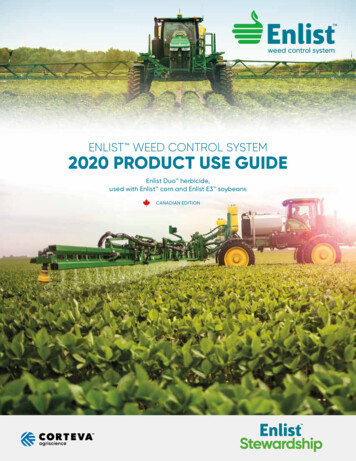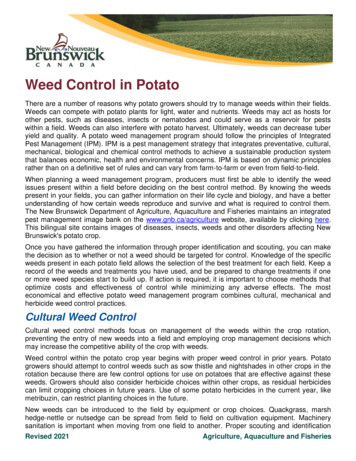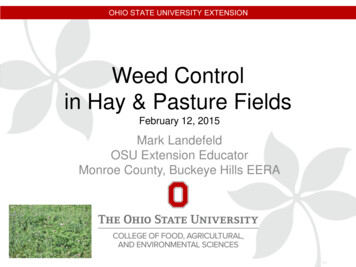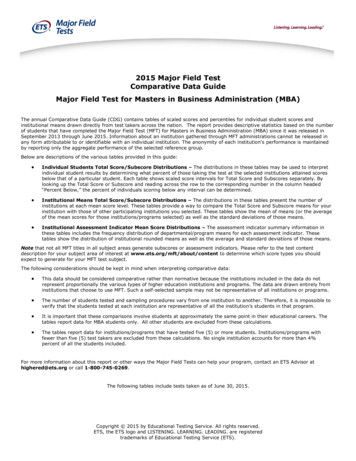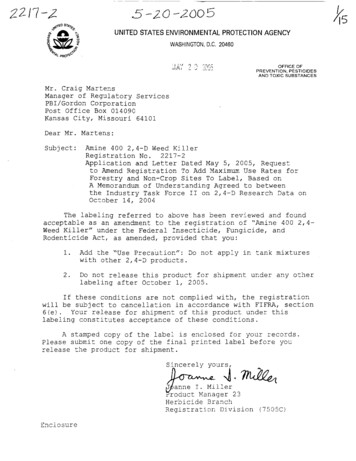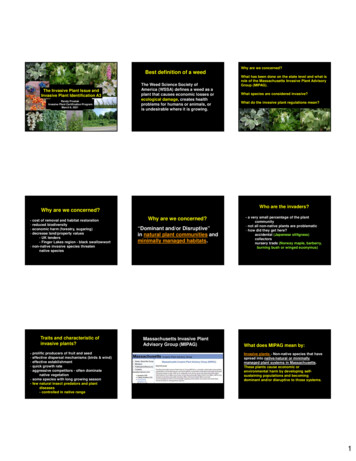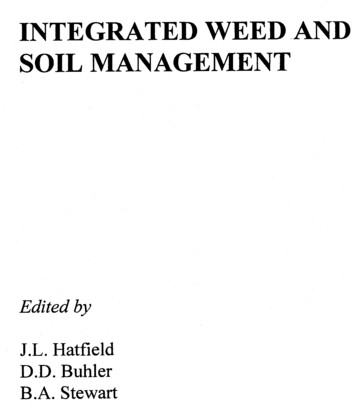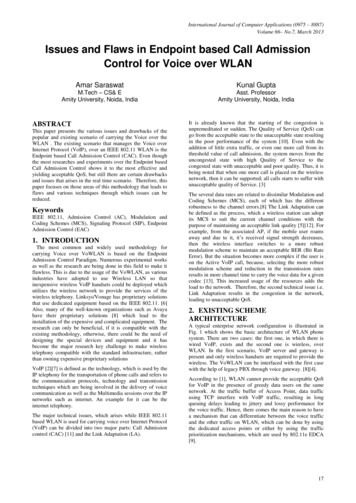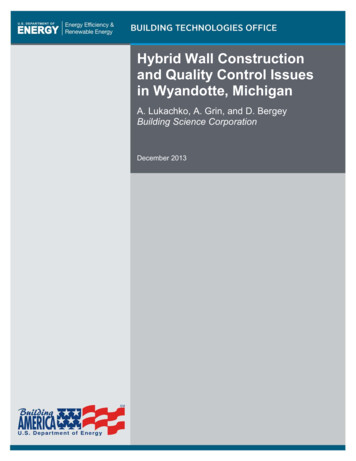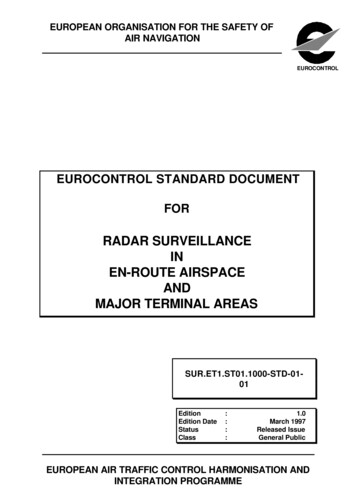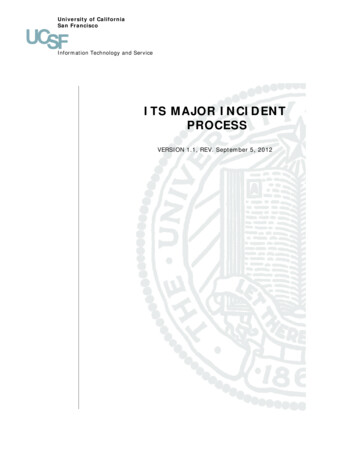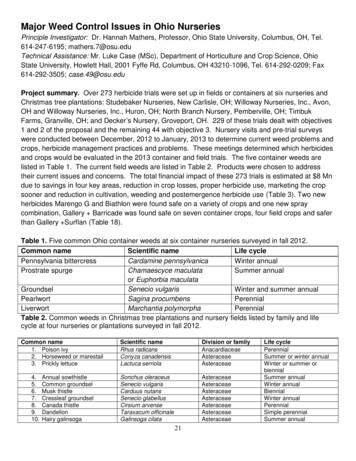
Transcription
Major Weed Control Issues in Ohio NurseriesPrinciple Investigator: Dr. Hannah Mathers, Professor, Ohio State University, Columbus, OH, Tel.614-247-6195; mathers.7@osu.eduTechnical Assistance: Mr. Luke Case (MSc), Department of Horticulture and Crop Science, OhioState University, Howlett Hall, 2001 Fyffe Rd, Columbus, OH 43210-1096, Tel. 614-292-0209; Fax614-292-3505; case.49@osu.eduProject summary. Over 273 herbicide trials were set up in fields or containers at six nurseries andChristmas tree plantations: Studebaker Nurseries, New Carlisle, OH; Willoway Nurseries, Inc., Avon,OH and Willoway Nurseries, Inc., Huron, OH; North Branch Nursery, Pemberville, OH; TimbukFarms, Granville, OH; and Decker’s Nursery, Groveport, OH. 229 of these trials dealt with objectives1 and 2 of the proposal and the remaining 44 with objective 3. Nursery visits and pre-trial surveyswere conducted between December, 2012 to January, 2013 to determine current weed problems andcrops, herbicide management practices and problems. These meetings determined which herbicidesand crops would be evaluated in the 2013 container and field trials. The five container weeds arelisted in Table 1. The current field weeds are listed in Table 2. Products were chosen to addresstheir current issues and concerns. The total financial impact of these 273 trials is estimated at 8 Mndue to savings in four key areas, reduction in crop losses, proper herbicide use, marketing the cropsooner and reduction in cultivation, weeding and postemergence herbicide use (Table 3). Two newherbicides Marengo G and Biathlon were found safe on a variety of crops and one new spraycombination, Gallery Barricade was found safe on seven container crops, four field crops and saferthan Gallery Surflan (Table 18).Table 1. Five common Ohio container weeds at six container nurseries surveyed in fall 2012.Common nameScientific nameLife cycleCardamine pennsylvanicaPennsylvania bittercressWinter annualChamaescyce maculataProstrate spurgeSummer annualor Euphorbia maculataSenecio vulgarisGroundselWinter and summer annualSagina procumbensPearlwortPerennialMarchantia polymorphaLiverwortPerennialTable 2. Common weeds in Christmas tree plantations and nursery fields listed by family and lifecycle at four nurseries or plantations surveyed in fall 2012.Common name1. Poison ivy2. Horseweed or marestail3. Prickly lettuce4.5.6.7.8.9.10.Annual sowthistleCommon groundselMusk thistleCressleaf groundselCanada thistleDandelionHairy galinsogaScientific nameRhus radicansConyza canadensisLactuca serriolaDivision or familyAnacardiaceaeAsteraceaeAsteraceaeSonchus oleraceusSenecio vulgarisCarduus nutansSenecio glabellusCirsium arvenseTaraxacum officinaleGalinsoga raceaeAsteraceaeAsteraceae21Life cyclePerennialSummer or winter annualWinter or summer orbiennialSummer annualWinter annualBiennialWinter annualPerennialSimple perennialSummer annual
11. Hairy bittercress12. Pennsylvania bittercress13. Wild mustardCardamine hirsutaCardamine pennsylvanicaBrassica kaber var.pinnatifidaLonicera maackiiSagina procumbensStellaria mediaCeraastium vulgartum14.15.16.17.Amur honeysuckleBirdseye pearlwortCommon chickweedMouse-eared chickweed18.19.20.21.Russian thistleYellow nutsedgeHorsetailProstrate spurge22.23.24.25.White cloverRed CloverPurple deadnettleHenbitSalsola ibericaCyperus esculentusEquisetum arvenseChamaescyce maculataor Eurphorbia maculataTrifolium repensTrifolium pretenseLamium purpureaLamium .Wild garlicNorthern willowherbCreeping red woodsorrelAnnual bluegrassShatter caneLarge crabgrassFall panicumYellow foxtailBarnyard grassQuackgrassCurly dockPurslaneWild carrotAllium vinealeEpilobium ciliatumOxalis corniculataPoa annuaSorghum bicolorDigitaria sanguinalisPanicum dichotomiflorumSetaria lutescensEchinochloa crusgalliElytrigia repensRumex crispusPortulaca oleraceaDaucus carotaBrassicaceaeBrassicaceaeBrassicaceaeWinter annualWinter eEquisetaceaeEurphorbiaceaeCreeping perennialPerennialWinter nnialWinter annualWinter nualPerennialCreeping perennialSummer annualPerennialSummer annualCreeping perennialWinter annualSummer annualSummer annualSummer annualSummer annualSummer annualCreeping perennialPerennialSummer annualWinterIn the winter 2012 to Jan., 2013 surveys, liverwort was found to be one of the fastestdisseminating weeds in Ohio nurseries. Even though liverwort trials were not required in the originalproposal, we determined the lack of known controls for this weed warranted addition to the AGRSCG-12-03 project. We added these liverwort trials under objective 3, regarding difficult weeds.Table 3. Summary of the Specialty Crop Block Grant (SCBG) financial impact of X herbicide trials atseven nurseries in 2012-13.Type of savingsReduction of croplossesProper herbicideselectionMarket crop soonerReduction incultivation, weedingand postemergenceherbicidesGrand TotalAmount1.5 MnNo. of sites2Total3.0 Mn0.5 Mn52.0 Mn2 Mn0.25 Mn222.0 Mn1.0 Mn8 Mn22
Project approachContainer studies. Phytotoxicity and weed control studies were carried out at four locations in Ohioincluding Studebaker Nurseries, North Branch Nursery, Willoway Nurseries, Inc., Avon, OH, andWilloway Nurseries, Inc., Huron, OH.Studebaker Nurseries. Three species of containerized ornamentals including viburnum (Viburnumx’Juddi’), daylily (Hemerocallis ‘Stella d’Oro), and hydrangea (Hydrangea paniculata ‘Little lamb’)were treated on 6 May 2013. Treatments included Marengo G at 100 lb/ac, 150 lb/ac, 200 lb/ac, and400 lb/ac; Gallery Barricade at 1.3 lb/ac 21 oz/ac, respectively; Biathlon at 100 lb/ac, 200 lb/ac,and 400 lb/ac; and BroadStar at 150 lb/ac. Reapplications were made approximately 6 weeks lateron June 17, 2013. Hydrangea and viburnum were in #3 (3 gallon) trade size pots and daylily wasin#1 (1 gallon) trade size pot at time of application.North Branch Nursery. Three species of containerized ornamentals including boxwood (Buxussempervirens ‘Vardar Valley’), rose (Rosa ‘Knockout’) and yew (Taxus xmedia ‘Runyon’) were treatedon April 23, 2013. Treatments included Marengo G at 100 lb/ac and 150 lb/ac; Gallery Surflan(oryzalin, Dow AgroSciences) at 1.3 lb/ac 2 qt/ac, respectively; Gallery Surflan at 1.3 lb/ac 1qt/ac, respectively; Tower Pendulum at 21 oz/ac 2 qt/ac; Tower Pendulum at 1 qt/ac 1 qt/ac,respectively; Biathlon at 100 lb/ac; and F6875 (sulfentrazone prodiamine, FMC Corp.) at 0.375 lbai/ac, 0.75 lb ai/ac, and 1.5 lb ai/ac. Reapplications were approximately 6 weeks later on June 4,2013. All species were in #3 trade size containers at time of application and just breaking dormancy.Willoway Nurseries, Huron. Six species of containerized ornamentals including rhododendron(Rhododendron ‘Nova Zembla’), Pieris (Pieris ‘Red Mill’), azalea (Azalea x’Karen’), holly (IlexXmeserveae ‘Blue Maid’), hydrangea (Hydrangea paniculata ‘Limelight’) and viburnum (Viburnumx’Juddi’) were treated on May 1, 2013. Treatments included Marengo G at 100 lb/ac, 150 lb/ac, 200lb/ac and 400 lb/ac; Gallery Barricade at1.3 lb/ac 21 oz/ac, respectively; Gallery Surflan at 1.3lb/ac 1 qt/ac, respectively; Tower Pendulum at 21 oz/ac 2 qt/ac, respectively; Tower Pendulum at 1 qt/ac 1 qt/ac, respectively; Biathlon at 100 lb/ac, 200 lb/ac, and 400 lb/ac; BroadStarat 150 lb/ac; and Gallery Ronstar (oxadiazon, Bayer Corp.) at 1 lb/ac 2 lb/ac, respectively.Reapplications were made approximately 8 weeks later on June 26, 2013. Rhododendron and Pieriswere in #1 size pots, azalea and holly were in #2 size pots, and viburnum and hydrangea were in #3size pots at time of application. All species had broken dormancy by time of first application. Due toa nutrient problem, the trials at Willoway Nurseries were terminated. Data taken at 1 WA2T, wascorrupted due to the nutrient issues at the site, and is not presented.Willoway Nurseries, Avon. Four species of containerized ornamentals including two cultivars ofhydrangea (Hydrangea macrophylla ‘Endless summer’ and Hydrangea arborescens ‘Invincible spirit’)rose (Rosa ‘Knockout’), and Itea (Itea ‘Little Henry’) were treated on April 19, 2013 with the exceptionof the ‘Endless summer’ hydrangea, which was treated on 1 May 2013. Treatments includedMarengo G at 100 lb/ac; Gallery Surflan at 1 lb/ac 1 qt/ac, respectively; Tower Pendulum at 21oz/ac 2 qt/ac, respectively; Tower Pendulum at 1 qt/ac 1 qt/ac, respectively; Biathlon at 10023
lb/ac; FreeHand at 150 lb/ac; Regal O-O at 100 lb/ac; and Jewel at 100 lb/ac. Reapplications weremade on June 26, 2013. All species were in #3 containers at time of application and had brokendormancy. Due to a nutrient problem, the trials at Willoway Nurseries were terminated. Data taken at1 WA2T, was corrupted due to the nutrient issues, and is not presented.At all locations, liquid applications were applied via CO2 backpack sprayer delivering 25 gal/ac andgranular formulations were applied via handheld shaker jars. Phytotoxicity visual ratings were basedon a 0-10 scale with 0 being no phytotoxicity and 10 death with 3 commercially acceptable.Treatments at Studebaker Nurseries and Willoway Nurseries were evaluated at 1 WAT, 2 WAT, 4WAT, and 1 WA2T; evaluations at North Branch were done 1 WAT, 2 WAT, 4 WAT, 1 WA2T, 2WA2T, and 4 WA2T. For phytotoxicity, treatment means were compared to a control using Dunnett’st-test with α 0.10 and 0.05 using Proc Mixed in SAS software.Field studies. Several trials were conducted to determine weed control and phytotoxicity fromseveral herbicides and herbicide combinations at three locations in Ohio, which included StudebakerNurseries, Inc., New Carlisle, OH; North Branch Nursery, Inc., Pemberville, OH, and Timbuk Farms,Granville, OH. Species at Studebaker Nurseries included boxwood (Buxus ‘Green velvet’) and yew(Taxus densiformus). Species at North Branch Nursery included eastern white pine (Pinus strobus)and white spruce (Picea glauca), and at Timbuk Farms, Canaan fir (Abies balsamea varphanerolepis). Liquid applications were applied via CO2 backpack sprayer delivering 25 gal/ac andgranular formulations were applied via handheld shaker jars. At each location, the rows were hoedjust prior to first treatment application.Studebaker Nurseries. Treatments were applied at Studebaker Nurseries on May 6, 2013 andincluded V-10366 (flumioxazin pyroxasulfone, Valent U.S.A.) at 7.5, 15, and 30 oz/ac, Tower Pendulum Aquacap (dimethenamid-p pendulum, both from BASF Corp.) at 32 oz/ac 2 qt/ac,respectively, and SureGuard (flumioxazin, Valent U.S.A.) at 6 oz and 12 oz/ac. Treatments werereapplied on June 17, 2013. Liquid applications were applied as directed sprays. For both boxwoodand yew, there were four replications/treatment and three subsamples/replication arranged in acompletely randomized design in the liner field for each species. Treatments were evaluated at 1WAT (weeks after treatment) 2 WAT, 4 WAT and 1 WA2T (weeks after second treatment).North Branch Nursery. Treatments were applied at North Branch on April 23, 2013 and includedGallery (isoxaben, Dow AgroSciences) Barricade (Syngenta Crop Protection, Inc.) at 1.3 lb/ac 21oz/ac, respectively; Tower Pendulum at 21 oz/ac 2 qt/ac, respectively; Tower Pendulum at 1qt/ac 1 qt/ac, respectively; Biathlon (oxyfluorfen prodiamine, OHP, Inc.) at 100 lb/ac; Marengo G(indaziflam, OHP, Inc.) at 150 lb/ac; V-10366 at 15 oz/ac; and SureGuard at 6 oz/ac. Treatmentswere reapplied on June 4, 2013. Liquid applications were applied as directed sprays. For eachspecies, there were four replications with three subsamples/replication for each treatment in acompletely randomized design within each species. Treatments were evaluated at 1 WAT, 2 WAT, 4WAT, 1 WA2T, 2 WA2T, and 4 WA2T.24
Timbuk Farms. Treatments were applied at Timbuk Farms on July 9, 2013 and included the sametreatments describe above for North Branch Nursery, and the treatments were reapplied onSeptember 3, 2013. At Timbuk, one species, Canaan Fir, Abies balsamea var phanerolepis alsoknown as West Virginia fir was used. However, there were two growth stages evaluated, which werenewly planted and trees in the ground for three years. Studies were also conducted in the fall of 2012with three growth stages, newly planted, 3 years old and trees in the ground 5 years. The results ofthe fall 2012 study were presented with the SCBG 11-08 project. Treatments were applied over-thetop of the newly planted trees and as directed applications for the older trees. For each growth stage,there were three subsamples/replication with four replications/treatment randomized in a completelyrandomized design. Treatments were evaluated at 1 WAT, 2 WAT, 3 WAT, 4 WAT, 1 WA2T, and 2WA2T.At all locations, phytotoxicity visual ratings were based on a 0-10 scale with 0 being no phytotoxicityand 10 death with 3 commercially acceptable. Efficacy visual ratings were based on a 0-10 scalewith 0 being no control and 10 perfect control with 7 commercially acceptable. For phytotoxicity,treatment means were compared to a control using Dunnett’s t-test with α 0.10 and 0.05 using ProcMixed in SAS software. For efficacy, treatment means were compared using lsmeans in ProcMixed with α 0.05.Liverwort trials. Trials were initiated at Decker’s Nursery, Inc., Groveport, OH on February 28, 2013in a covered hoop house that had minimum heat to protect plants from frost. Liquid applications ofSureGuard (flumioxazin, Valent U.S.A) at 3 oz and 4 oz/ac; WeedPharm (20% acetic acid, PharmSolutions, Inc.) at 10% v/v; and Marengo SC (indaziflam, Bayer Corp.) at 9 oz/ac were applied with aCO2 backpack sprayer delivering 50 gal/ac. A 100 gal/ac rate was desired, so two passes weremade at each application. Treatments of baking soda and reagent grade potassium bicarbonate(Sigma-Aldrich Corp.) were also each applied at approximately 2.24 g/ft2 with a Dustin-Mizer orhandheld shaker jar. A second application was made on April 26, 2013. For phytotoxicity,ornamental species included barberry (Berberis ‘Orange Rocket’), boxwood (Buxus microphylla‘Winter gem’), hydrangea (Hydrangea arborescens ‘Incrediball’), and Physocarpus (Physocarpus‘Summer wine’). Evaluations of efficacy and phytotoxicity were conducted at 1 WAT (weeks aftertreatment), 2 WAT, 4 WAT, 8 WAT, 1 WA2T (weeks after second treatment), 2 WA2T, and 4 WA2T.Phytotoxicity visual ratings were based on a 0-10 scale with 0 being no phytotoxicity and 10 deathwith 3 commercially acceptable. Efficacy visual ratings were based on a 0-10 scale with 0 being nocontrol and 10 perfect control with 7 commercially acceptable. The trial was set up as a completelyrandomized design for each species with three replications/treatment and threesubsamples/replication. For phytotoxicity, treatment means were compared to a control usingDunnett’s t-test with α 0.10 and 0.05 using Proc Mixed in SAS software. For efficacy, treatmentmeans were compared using lsmeans in Proc Mixed with α 0.05.Difficult weeds. Rorippa trials. Addressing objective 3, in pre- project start surveys we found thatliner bed growers were using the following herbicides, Rout, Barricade, Snapshot, SureGuard,Pendulum, Round up, Goal, Tower, Lontrel and 2, 4-D. On average, they were spending 2300.00/ac to hand weed problem areas with difficult weeds such as Rorippa. We had targeted to reduce25
their weed program cost by 30%. We accomplished this goal. The acceptable use of Lontrel in thisstudy provided 35% control, thus reducing hand weeding costs by 35%. We recommend more workwith Lontrel on more species and with lower rates to reduce phytotoxicity.Two trials were conducted in fields, one as a preemergence study, and the other apostemergence study. Evaluations for the pre- and post- emergence trials consisted of visual ratingsof weed control and phytotoxicity to crop species. Visual ratings of weed control were based on a 010 scale with 0 being no control and 10 perfect control with 7 commercially acceptable. Visualratings of phytotoxicity were based on a scale of 0-10 with 0 being no phytotoxicity and 10 death with 3 commercially acceptable. Data was analyzed using SAS GLM. Phytotoxicity effects oftreatments were compared to the controls using Dunnett’s t-test (α 0.10 and 0.05). Efficacytreatments were compared to each other using least significance difference (ls means).The preemergence trial was started on April 4, 2013 in a liner bed of Common purple lilacs(Syringa vulgaris) that had not yet broken dormancy and were approximately 6” (15 cm) tall. Weatherat time of application was sunny, approximately 40 F with no dew present. Six herbicides and oneherbicide mulch were compared to an untreated control. Herbicides included Corsair (chlorsulfuron,Nufarm Americas, Inc.) at 5.3 oz/ac, Certainty (sulfosulfuron, Monsanto Corp.) at 1 oz/ac,SedgeHammer (halosulfuron, Gowan Co.) at 2 oz/ac, Lontrel (clopyralid, Dow Agro Sciences) at 1pt/ac, V-10336 (no trade name yet, flumioxazin pyroxasulfone, Valent U.S.A.) at 15 oz/ac, andDiuron 80 (diuron, Drexel, Inc.) at 3 lb./ac. For the herbicide mulch treatment, Casoron CS(dichlobenil, Chemtura Corp.) at 3 gal/ac was applied just prior to application of 2 inches of pinenugget mulch. The herbicides were applied with a CO2 backpack sprayer delivering 25 gal/ac. Thecreeping yellow cress was just beginning to green below the soil surface. Plots were approximately 3’x 3’ with approximately 1-2’ between plots.The postemergence trial treatments were also conducted on Common purple lilacs (Syringavulgaris); however, unlike the preemergence trial, the lilacs had broken dormancy at the time ofapplication and were approximately 7” (17.5 cm) tall. Applications were made on May 16, 2013.Weather was approximately 65 F, 5 mph wind, sunny. Herbicides included: Corsair (chlorsulfuron,Nufarm Americas, Inc.) at 5.3 oz/ac, Certainty (sulfosulfuron, Monsanto Corp.) at 1 oz/ac,SedgeHammer (halosulfuron, Gowan Co.) at 2 oz/ac, Lontrel (clopyralid, Dow Agro Sciences) at 1pt/ac, V-10336 (no trade name yet, flumioxazin pyroxasulfone, Valent U.S.A.) at 15 oz/ac, Diuron80 (diuron, Drexel, Inc.) at 3 lb/ac, Classic (chlorimuron, Dupont Crop Protection) at 2/3 oz/ac, andMarengo SC at 9 oz/ac. All treatments included the addition of nonionic surfactant at 0.25% v/v.Herbicides were applied with a CO2 backpack sprayer delivering 25 gal/ac.Container results.Studebaker Nurseries. Marengo G was phytotoxic to all three species; however, daylily injury was atcommercially acceptable levels (Fig. 1A) for all dates and rates and decreased after the secondapplication (Table 4). Marengo G injury to Hydrangea paniculata, however, was not commerciallyacceptable and continued after the second application (Table 4) (Fig. 2 C). We speculate that the 200lb. rate of Marengo was never applied. Marengo injury to Viburnum X ’Juddi’ was the least of thethree species evaluated and was commercially acceptable at all rates after the first application. The26
second application, however, significantly increased injury at all rates after the second application andwas not commercially acceptable at 400 lb./ac 1WA2T (Table 4).AFig. 1. A, B and C. (A) (left) Marengo G at 400 lb/ac 2 WAT (2.4rating) at Studebaker Nurseries, Inc., New Carlisle, OH onHemerocallis 'Stella d'Oro' although the injury from Marengo issignificant it is far less severe than the injury caused by Biathlon400 lb/ac 2WAT (rating 5.4) (B) (below) or Broadstar (150 lb/ac)(C) (below). (pictures taken by H. Mathers).CBGallery Barricade showed some passing phytotoxicity to Hydrangea paniculata (Fig. 2 A)
The total financial impact of these 273 trials is estimated at 8 Mn . and 400 lb/ac; and BroadStar at 150 lb/ac. Reapplications were made approximately 6 weeks later on June 17, 2013. Hydrangea and viburnum were in #3 (3 gallon) trade size pots and daylily was .
